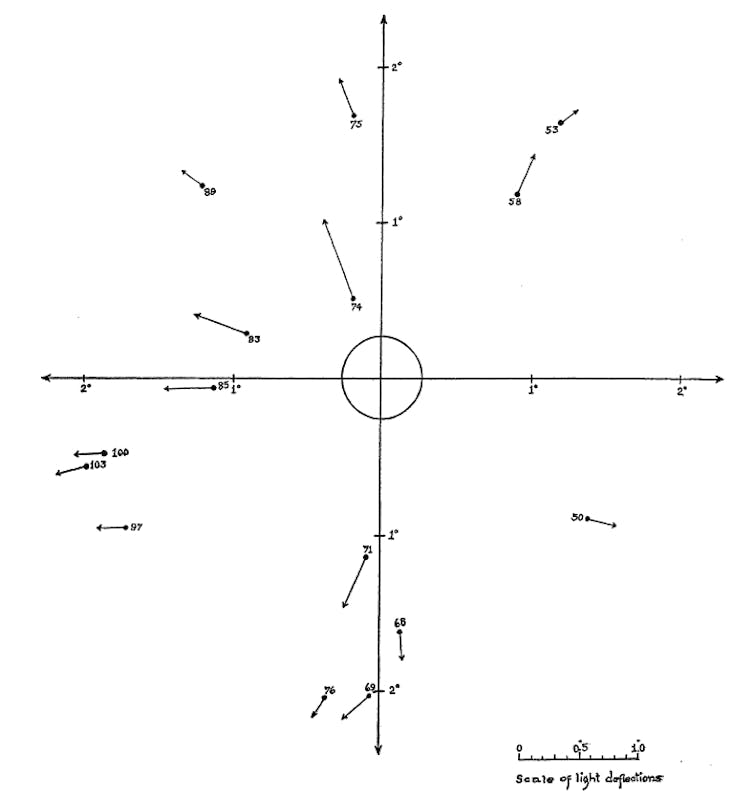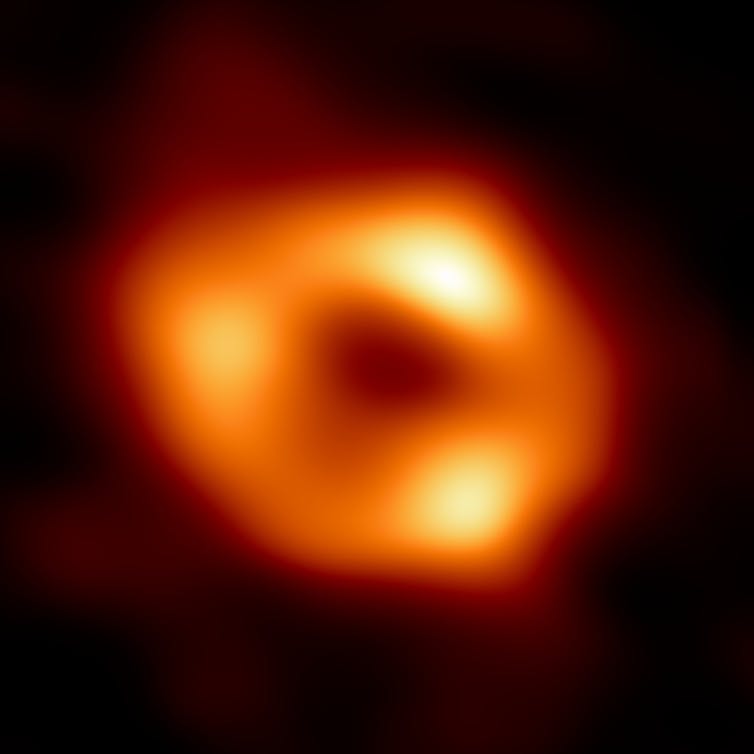During night-like conditions created during the totality of a solar eclipse, like that of April 8, planets and stars are visible. Venus and Jupiter, bracketing the sun, will be very noticeable, while Mercury will be rather faint.
There won't be any bright stars near the sun during this eclipse, but, amazingly, dim stars near it will appear displaced by a small amount due to its gravity. This displacement, and the motion of Mercury, were the earliest evidence in the early 20th century that confirmed Einstein's new theory of gravity. These observations also led directly to the prediction of black holes.
With the amazing power of modern telescopes, our "best of" astronomy websites have abundant evidence of gravity bending light, acting like a lens. If the alignment of a background object with a gravity lens is almost perfect, an "Einstein ring" of light appears like a halo around it.
Bending light
The earliest modern studies of light were published by Sir Isaac Newton in the early 18th century. Despite some of his discoveries now being strong evidence for light being waves, he concluded at the time that light was made of particles and would indeed be affected by gravity.
The French mathematician Pierre-Simon Laplace even proposed, in 1795, that gravity could be strong enough to pull light into a body, an early concept of black holes. However, by the late 19th century, Newton's ideas on light were discarded, and it was thought to be waves, and thus unaffected by gravity.
We now know that light has two aspects, waves and particles combined, but it took the genius of Einstein to realize that this does not even matter: it was our understanding of gravity that needed to change, and he proposed the general theory of relativity.
Although it was published in full form in 1915, already in 1911 Einstein predicted that light would be bent by gravity. Einstein's full theory immediately resolved a long-standing problem that Mercury's position did not agree with the predictions made using Newton's gravity theory, a great triumph.
Observing the bending of light appeared to be a good second test of the revolutionary new concept of gravity as "curved spacetime," but only the sun, about 330,000 times more massive than Earth, was strong enough to bend light slightly. Since the source of the light would be stars, the effect could be observed only during an eclipse when they could be seen near the sun.
The effect is very small, less than one-thousandth of the angle the disc of the sun-or the moon-makes in the sky.

(W. W. Campbell and R. J. Trumpler/Lick Observatory Bulletin)
New equipment, new observations
Astronomers started hauling tons of equipment, including telescopes up to five metres in length, to eclipse paths to make high-precision measurements. The stars where the eclipse would occur had to be photographed months in advance at night and then photographed with the same large telescope during the eclipse.
The noted English astronomer, Sir Arthur Eddington, made the first conclusive observations in 1919 from observation sites in South America and Africa. This tiny effect is imperceptible to casual viewers of an eclipse but had big implications, resulting in the totally different field of study of classifying stars.
It was noticed in 1910 that there was a strange star called 40 Eridani that was much fainter than it should have been, considering its high temperature. It seemed some stars could have about the mass of the sun, but only be the size of a planet.
These were soon dubbed "white dwarfs" and in 1930, the young Indian astrophysicist Subrahmanyan Chandrasekhar discovered that they must be less than about one and a half times the mass of the sun, otherwise they would collapse. The discovery of the neutron in 1932 led to the idea of neutron stars, more compact than white dwarfs, but even they have a mass limit.
In 1939, Robert Oppenheimer and colleagues modernized the Laplace idea of collapse to black holes using Einstein's theory, but in that year war broke out, famously diverting his attention.
Black holes seemed of little interest and even less reality until the topic was revived in 1968 by physicist John Wheeler, who had some trouble publishing the name "black hole" as it was deemed risqué.
Soon, some binary stars were found that seemed to have very massive unseen companions. It was also realized that the enigmatic and very distant quasars could be explained using black holes. It now appears that most large galaxies, including ours, have black holes at their centres.

(EHT Collaboration)
Bending power
A few years ago, the Event Horizon Telescope consortium of radio telescopes imaged our galaxy's black hole, which bends light and radio waves in a characteristic way so that its central region appears dark. Although black holes have the most bending power, agglomerations of mass in deep space-including mysterious dark matter-also bend light. Since light from the distant objects they magnify for us took a long time to get here, it started its trip when the universe was young. This allows us to look back in time.
During the solar eclipse on April 8, other stars may be visible, but without observing and measuring their positions previously, viewers may not be able to tell that they are not where they should be. But it's a good time to recall that the path to black holes started about a century ago, with that faintly visible Mercury-and starlight bent by the sun. ![]()
This article is republished from The Conversation under a Creative Commons license. Read the original article.